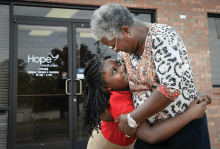racial wealth gap

IN THE 1960s, Louise Morphis stored her money in a neighbor’s garage in the small town of Bynum, N.C. The rural Southern town’s white-run banks refused to serve the Black community, so the neighbor, vice principal of the local Black public school, housed a credit union in his garage through the 1990s.
“Some people go to the bank, some people have to go to the garage,” Morphis’ grandson, William J. “Bill” Bynum, told Sojourners. Those early memories of economic injustice stayed with Bynum, who was born in East Harlem and moved with his family when he was age 5 back to Bynum—“an old mill town actually named after my ancestors who had once worked there as slaves,” Bynum told the Delta Business Journal last fall.
In 1995, Bill Bynum helped found his own version of the “garage bank” his grandmother used. That seedling project, begun in the tithing room of a church in Jackson, Miss., became Hope Credit Union. Today, Hope has 23 branches and has generated more than $3.6 billion in financing in the Mississippi Delta region and across the Deep South.
Hope found its purpose in places where—as in Bynum’s hometown—entrenched generational poverty can be traced back to slavery. “If you look at a map of the country prior to the Civil War, and where slavery was concentrated, and a map today of where you have the worst job conditions, housing conditions, education outcomes, health outcomes, and where you have the fewest banks and the most payday lenders, they’re the same,” said Bynum, who serves as CEO of Hope Credit Union. “There’s a legacy of underinvestment and—no other way to describe it—institutional discrimination that limits opportunity.”

Recent studies from both the Urban Institute and the Pew Forum tell the story of America's growing racial wealth gap. In the May issue of Sojourners magazine, Otis Moss III talked about the unjust trend:
The call of the church has been, and always will be, to become the compassionate hands and feet of Christ. Poverty, when attached to race, is the original sin of America, a country built by slave labor and enriched by the unfair labor practices of the Industrial Revolution.
Read the full piece HERE.

See the full infographic at the jump.